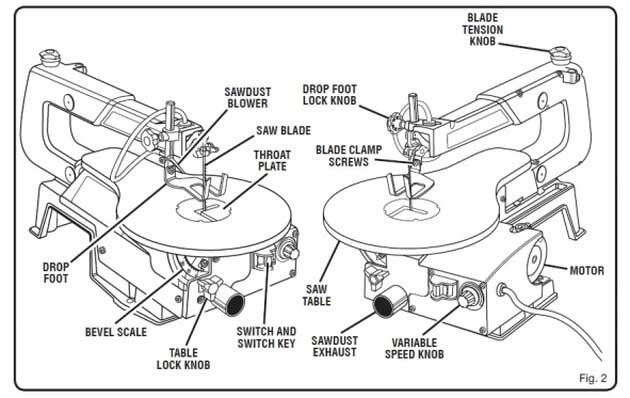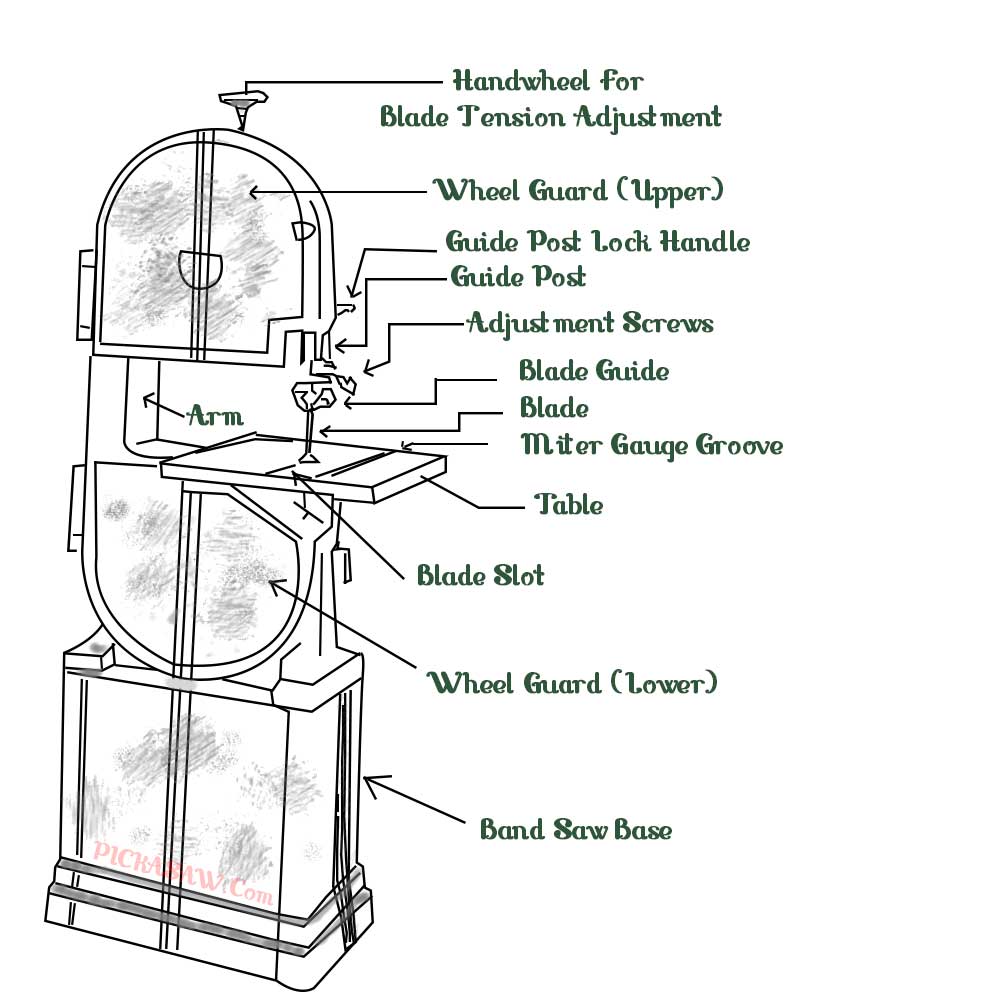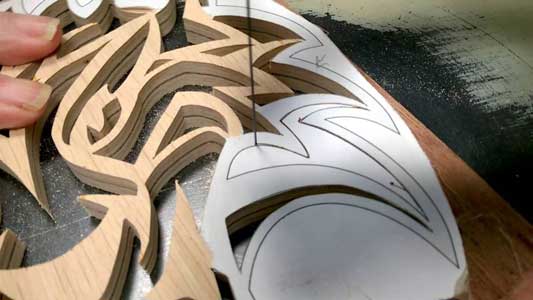They may look the same, but they aren’t the same. Scroll saws and band saws have different functions and are suited to different tasks. So which of the two is ideal for you? To answer this question, you have to first understand the differences between the two.
In this article, we will be looking at the band saw vs. scroll saw; which is better? Obviously, both saws appeal to a different demographic. Thus, it is important to know what each one can do before splashing money on one.
A comparison of the bandsaw vs. scroll saw reveals that while they differ, they have some similarities. It is important to point out some of these similarities before getting to the differences.
The main similarity is that they both feature a table with a blade running perpendicular through the center of the table. And with that, it is pretty clear that both saws are very different from common saws, such as circular, table, and miter saws.
The Scroll Saw
To understand how these two saws differ, let us look at each one separately, starting with the scroll saw. Scroll saws use thin and short blades whose thickness is usually less than a quarter. These vertical blades move up and down at speeds of up to 1800 strokes per minute.
Predominantly used for cutting wood, these saws feature a flat table where the material being cut is placed and an overhead arm. The blade is attached to the arm that extends over the table and runs from the end of the arm through the table to the bottom of the saw.
When shopping for a new scroll saw, there are two crucial factors to consider. These are the saw’s throat size and its blades.

Throat size
These saws are usually measured in terms of throat size. So what exactly is the throat size? This is the size of the blade from the table to the frame of the extended arm. Why this is so important is because it determines the thickness of material that can be cut by the saw.
Throat sizes range between 12 inches and 30 inches. A 12-inch throat size is ideal for cutting wood of about 24 inches across or less in size. On the other hand, larger 30-inch throat sizes are ideal for cutting larger pieces of wood.
Scroll saw blades
One of the major band saw vs. scroll saw differences is the blade. Scroll saws usually come with thinner and shorter blades of about 6 inches in length. This is because scroll saw blades move up and down when cutting.
Despite their size and thickness, these blades come in a variety of options. You can choose either double tooth, crown, or spiral blades. Furthermore, blades made of hardened steel are also available for cutting through metal.
For cutting glass, you can opt for a diamond blade. There is also the option of a rear tooth blade for cutting thinner and softer wood. This type of saw blade reduces splintering but heats up faster, which increases wear and tear.
The Band Saw
Band saws use a long continuous blade stretched between two or more wheels in the same manner as a cassette tape. The design of their blades is why they are called band saws.

Similar to a scroll saw, the band saw has a flat table, and part of the blade protrudes through it at the center. To cut material, you place it on the flat table and push it towards the rotating blade. As for the throat size, in a band saw, this term refers to the width of the wheels.
It is the wheels that give the flexible blades their continuous shape. Also, since the blade is open in the front and rear, you can cut different-sized materials. In essence, this type of saw works pretty much as a table saw. If you are interested in trying our best 14-inch bandsaw review, you can check why they are great for cutting thick wood.
The main difference is that with a band saw, you can cut thinner pieces compared to the table saw. Compared to scroll saws, band saws are very powerful and can thus be used to cut metal. They are predominantly used in woodworking as well as metalworking.
Scroll saw Pros and Cons
Pros
- Scroll saws are the best tools for making intricate carvings, crafts, and shapes on wood
- These saws offer a precise, accurate, and clean-cut thus, you do not need to sand after sawing, thanks to the blade being thinner and smaller
- It can be used for cutting out shapes inside a material, thanks to the fixed nature of the saw
- There is a wide variety of scroll saw blades to choose from for cutting different materials and are thus not limited to wood only.
Cons
- Scroll saws are not designed for cutting thick materials and will struggle to cut through materials that are 2 inches and over thick.
- While they can be used to make straight cuts, they are not the best for this.
The Band Saw Pros and Cons
Pros
- Compared to the scroll saw, band saws are better at cutting thicker materials. Also, with the right blade can be used to cut different materials metal included
- Thanks to the bigger and thicker blades on the band saw, making straight cuts is much easier than with a scroll saw
- Due to them being more powerful, band saws are able to cut thick materials with improved speed and accuracy.
- It can be used for ripping lumber and is one of the purposes they were invented for
Cons
- The band saw produces aggressive cuts that will leave the material you are cutting with rough edges.
- Unlike a scroll saw, a band saw is incapable of making inside plunge cuts.
Bandsaw vs. Scroll Saw: The Differences
Purpose
The difference between these two saws becomes clear when you consider what they are designed to do. Scroll saws are built for intricate and delicate cuts. The kind of cuts you need when creating intricate carvings on a piece of wood.
On the flip side, the band saw is built for cutting thick materials. Much like a table saw, band saws can make straight cuts on thicker materials. This is inclusive of metals and wood.

Thickness
Since they are built for intricate and delicate cuts, scroll saws have thin and short blades. On average scroll saw, blades measure 6 inches in length and ¼ inch in thickness. This is why they are not suited to cutting thick materials.
Band saws have thicker and tough blades. These blades can cut thicker materials with ease. A horizontal band saw is capable of cutting materials measuring 6 inches to 30 inches in thickness.
Cutting
The scroll saw seems to be specifically designed for making circular cuts and curves. Also, it is suited to making detailed cuts. Contrastingly, band saws are suited to making straight cuts and underperform when it comes to circular cuts.
Versatility
In regards to versatility, scroll saws are more versatile. Band saws are generally used for making straight cuts. You can make different cuts with a scroll saw.
Budget
So which of the two is more affordable? Generally, scroll saws are cheaper than band saws. The latter is designed more for professional use hence why they are costlier.
Frequently Asked Questions
When should I use a scroll saw?
When you want to make detailed cuts inside a piece of wood or when you are carving something on your workpiece.
When shouldn’t you use a scroll saw?
When you need to make a straight cut on a thick piece of wood, ideally, any material that is more than 2 inches thick.
When should I use a band saw?
When you need to cut a workpiece that is more than 2 inches in thickness, in particular when you want to rip or make a straight cut.
When shouldn’t I use a band saw?
When you want to make detailed or intricate cuts inside a workpiece or when you want to carve out a shape on your workpiece.
Conclusion
In the battle or band saw vs. scroll saw, both saws emerge victoriously. No one is better than the other as they are both designed for different tasks. Therefore, when wondering which between the two you should choose, it depends on what you want to do.
Due to them being more affordable, scroll saws are preferred by DIYers, while professional contractors prefer band saws. In conclusion, both saws have a lot to offer.
